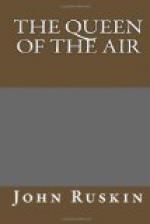This force, now properly called life, or breathing, or spirit, is continually creating its own shell of definite shape out of the wreck around it; and this is what I meant by saying, in the “Ethics of the Dust,” “you may always stand by form against force.” For the mere force of junction is not spirit; but the power that catches out of chaos charcoal, water, lime, or what not, and fastens them down into a given form, is properly called “spirit;” and we shall not diminish, but strengthen our conception of this creative energy by recognizing its presence in lower states of matter than our own; such recognition being enforced upon us by delight we instinctively receive from all the forms of matter which manifest it; and yet more, by the glorifying of those forms, in the parts of them that are most animated, with the colors that are pleasantest to our senses. The most familiar instance of this is the best, and also the most wonderful: the blossoming of plants.
60. The spirit in the plant—that is to say, its power of gathering dead matter out of the wreck round it, and shaping it into its own chosen shape—is of course strongest at the moment of its flowering, for it then not only gathers, but forms, with the greatest energy.
And where this life is in at full power, its form becomes invested with aspects that are chiefly delightful to our own human passions; namely, at first, with the loveliest outlines of shape; and, secondly, with the most brilliant phases of the primary colors, blue, yellow, and red or white, the unison of all; and, to make it all more strange, this time of peculiar and perfect glory is associated with relations of the plants or blossoms to each other, correspondent to the joy of love in human creatures, and having the same object in the continuance of the race. Only, with respect to plants, as animals, we are wrong in speaking as if the object of this strong life were only the bequeathing of itself. The flower is the end or proper object of the seed, not the seed of the flower. The reason for seeds is that flowers may be; not the reason of flowers that seeds may be. The flower itself is the creature which the spirit makes; only, in connection with its perfectness is placed the giving birth to its successor.
61. The main fact then, about a flower is that it is part of the plant’s form developed at the moment of its intensest life; and this inner rapture is usually marked externally for us by the flush of one or more of the primary colors. What the character of the flower shall be, depends entirely upon the portion of the plant into which this rapture of spirit has been put. Sometimes the life is put into its outer sheath, and then the outer sheath becomes white and pure, and full of strength and grace; sometimes the life is put into the common leaves, just under the blossom, and they become scarlet or purple; sometimes the life is put into the stalks of the flower and they flush blue; sometimes into its outer enclosure or calyx; mostly into its inner cup; but, in all cases, the presence of the strongest life is asserted by characters in which the human sight takes pleasure, and which seem prepared with distinct reference to us, or rather, bear, in being delightful, evidence of having been produced by the power of the same spirit as our own.




